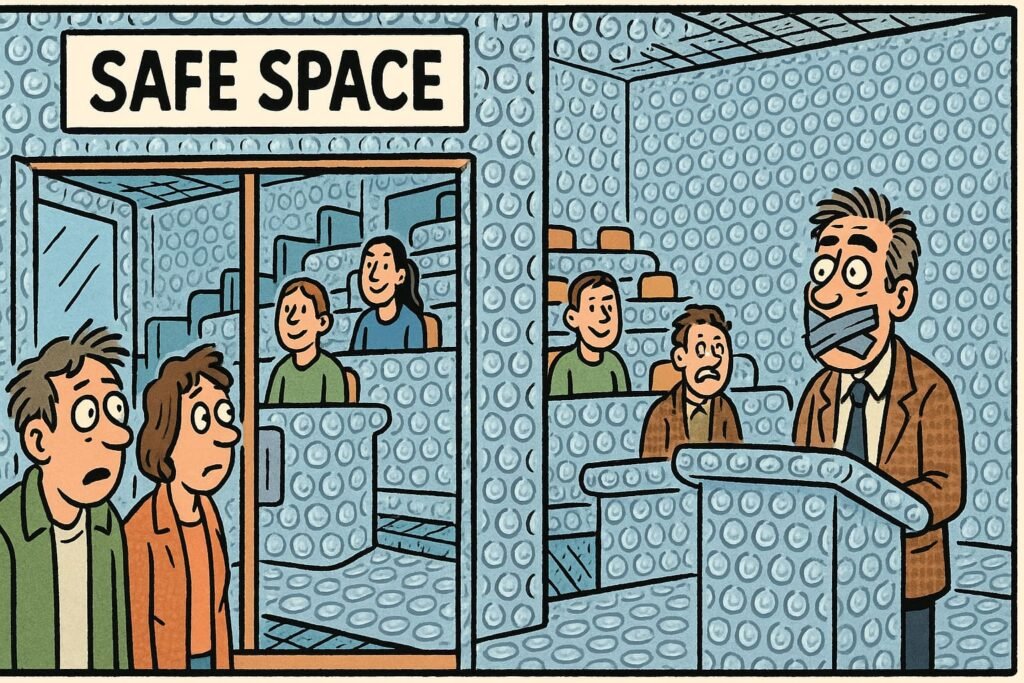Safe Spaces Explained: Comfort Over Conversation
When Shelter Becomes a Cage
Originally, a safe space was somewhere practical: a refuge for battered women, or a student group needing privacy.
But in the modern activist playbook, safe spaces expanded into classrooms, workplaces, and even politics. No longer about safety from violence, they’re about protection from ideas.
It’s comfort over conversation — and the death of disagreement.
Table of contents
What Are Safe Spaces?
A safe space is defined as an environment where individuals or groups can feel free from emotional harm, discrimination, or “triggering” content.
Sounds harmless. But in practice, it means filtering out anything that challenges the dominant activist narrative. A “safe” space quickly becomes an echo chamber.
Buzzwords
The concept thrives on soft, disarming language:
- “Inclusive environment” – Code for censorship.
- “Trigger warnings” – Pre-emptive flags for ideas some might dislike.
- “Zero tolerance” – Rules that remove anyone with the wrong opinion.
- “Safe and brave spaces” – Brave enough to agree, never brave enough to dissent.
The vocabulary makes censorship sound compassionate.
How It Shows Up in Practice
- Universities cancel speakers because their ideas aren’t “safe.”
- Workplaces ban words or jokes that could “harm” colleagues.
- Media sanitises coverage to avoid offending activists.
- Politics drafts laws criminalising “unsafe” speech.
Everywhere safe spaces appear, free expression disappears.
Why Institutions Promote It
Because it’s risk management disguised as morality.
- Universities avoid student protests by banning ideas.
- HR departments prevent lawsuits by policing speech.
- NGOs sell the idea of “psychological safety” to donors.
- Corporations use safe spaces as PR — proof they’re “progressive.”
SS protect institutions, not people.
The Consequences
- Silenced debate. Tough conversations never happen.
- Infantilisation. Adults treated like fragile children.
- Division. Dissenters pushed out, activists reinforced.
- Intellectual stagnation. Without challenge, ideas rot.
A culture obsessed with SS ends up fragile, not strong.
Why It Matters
Safe spaces sound harmless, but they change how universities teach, how offices run, how media reports, and how politics legislates.
Instead of building resilience, they reward fragility. Instead of freedom, they offer padded walls.
From Shelter to Censorship
Safe spaces promised safety. What they delivered was censorship.
It’s not protection. It’s a padded cage.
FAQ
What are safe spaces in plain terms?
Areas designed to shield people from offensive or uncomfortable ideas.
Where did the concept of safe spaces come from?
Originally from activist movements in the 1960s and 1970s, later expanded into mainstream institutions.
Why are they controversial?
Because they prioritise emotional comfort over open debate and free speech.
Who benefits from them?
Universities, HR departments, NGOs, and corporations that use them as PR or liability shields.
How do SS link to microaggressions and DEI?
They are the “solution” to microaggressions. In DEI programs, they enforce conformity by removing dissent.
See also: Inclusion Explained.



